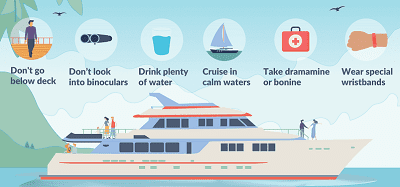Private Scuba › Snorkeling Blog › Preventing Motion Sickness
Tips for Preventing Sea Sickness
Boat rock and roll motion results in brain confusion and mental disarray. This is the main cause of seasickness for people who go snorkeling from boats.
As a snorkeler, knowing how to prevent motion sickness can help you avoid bouts of nausea and vomiting while at sea.
How Can You Prevent Seasickness at Sea?
In fact, anyone who suffers from pelagism already knows how sicky and miserable the experience can be.
Trying to avoid, prevent, and treat motion sickness while sailing at sea is not easy. It is a nauseating inconvenience for some… and a wretched nightmare for others.
Apart from abandoning the ship, we have some extra tips for beginner snorkelers to avoid sea sickness. Check out the practical suggestions to help you reduce the onset of nausea and attempt to control dizziness.
Note: The full definition of pelagism is a type of motion sickness which is most often caused by the motion of a floating platform (e.g. a boat, raft, or ship).
As mentioned before, mental confusion is the primary reason why some boat passengers get motion sickness. Your feet convince you that you are standing or sitting on solid ground. But, other parts of your body disagree.
They remind your brain about the rocking and rolling motion of the boat if it's on a choppy sea. The result is brain confusion – and you get seasick (also called 'mal de mer' in French language).
Here's the bottom line:
Some Centres for Disease Control (CDC) studies suggest that almost 100% of boat passengers will suffer a form of queasy motion sickness if the ocean is rough.
Some people experience naupathia (a sickly shade of green around the gills) every time they sit on a vessel that is traveling on water. This is irrespective of the sea conditions.
Scientific research about seasickness prevention shows that pelagism is mostly hereditary. That means the sensory mismatch gene is likely to get passed down to you by your parents.
 Tip 1. Avoid Looking Down
Tip 1. Avoid Looking Down
The first step of seasickness prevention, and it will be the cure in some cases, is to look out towards the stable horizon. Hence, you should avoid looking down into the water.
Instead, targeting your view on the horizon will encourage your eyes and inner ears to send uniform signals to your brain.
Doing so will reduce the amount of mixed messages it receives. Furthermore, try to avoid reading or focusing your eyes on a moving target.
Try to find a central position on the boat - low down near to sea level. The unstable rocking and rolling movement of the boat will be less amplified on lower decks than it will be on the top deck.
If you can find somewhere to lie down, and then close your eyes, this will also help to give your brain a no-motion signal.
Tip 2. Drink Coca Cola
Reports suggest that drinking Coke® may help to calm a nauseated stomach. Coca cola contains some sugars and phosphoric acid – found in many anti-nausea drugs.
You could also consider taking Emetrol for nausea. It is an over-the-counter anti-emetic drug that helps to relieve nausea and vomiting.
But wait - there's more...
There are other tips to avoid sea sickness or help suppress nausea found on the market. They include acupressure bands such as Sea-Band and Acuband.
Medical patches like Transderm Scop, or the MQ Motion Sickness Patch for boat rides, release a drug that reduces the activity of the inner ear nerve fibers.
But, most medication and pills need some hours to take effect. Always follow the manufacturer’s safety guidelines.
Note: You can buy Sea-Band drug free nausea relief wristbands online from Amazon and they can be a comforting answer to sickness.
Tip 3. Stay Sober
The best tips to avoid sea sickness also relate to alcohol intake. We would never suggest engaging in boat travel when you are suffering from a hangover. Even so, alcohol, dehydration, and fatigue will increase the likelihood of suffering seasickness.
Try to eat a small meal before embarkation. But, there are some foods to avoid more than others. The bad ones include greasy foods and acids. Even so, a light snack may help to settle your belly.
Important: Anxiety is also thought to be a contributing factor for seasickness. Hence, keep this in mind when understanding how to prevent motion sickness when snorkeling at sea.
Sickness or Vomiting On Board
If your methods of seasickness prevention fail, you may feel like you want to retch and throw up (be sick). Thus, being aware of the early warning signs and symptoms will help. They include:
- Headache
- Excessive burping
- Body chill
Move towards the leeward side of the boat (downwind). Take someone with you to supervise you while you throw up. They will also be able to help stop you falling overboard while you vomit over the rail (or into a bucket).
Inform the boat crew of your illness and they will advise you where it is best to be sick. After you have emptied your stomach you are likely to feel a little better. Even so, you may not fully recover until you reach dry land.